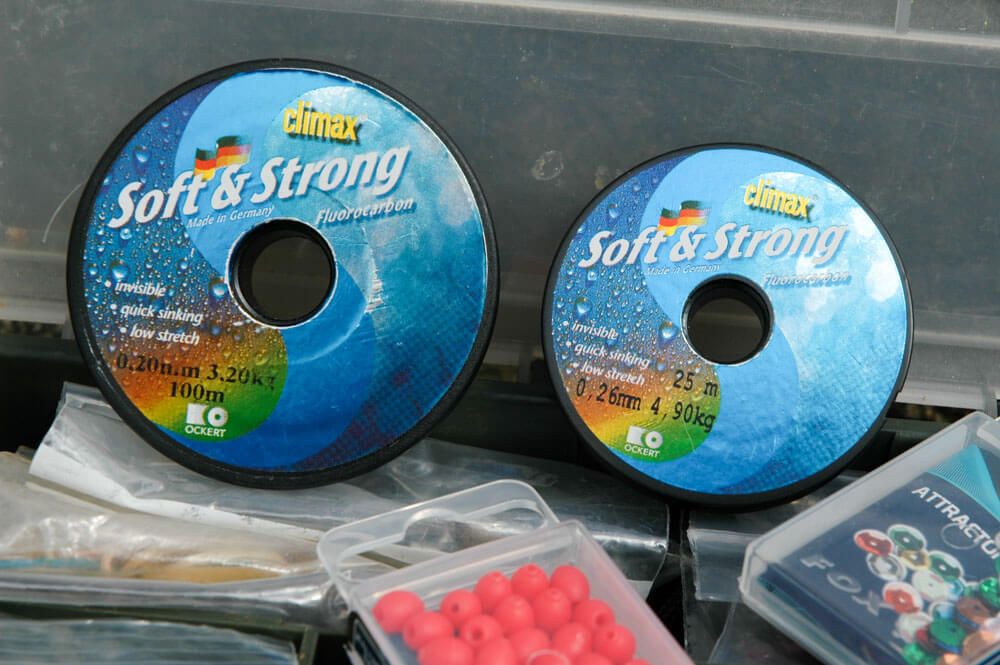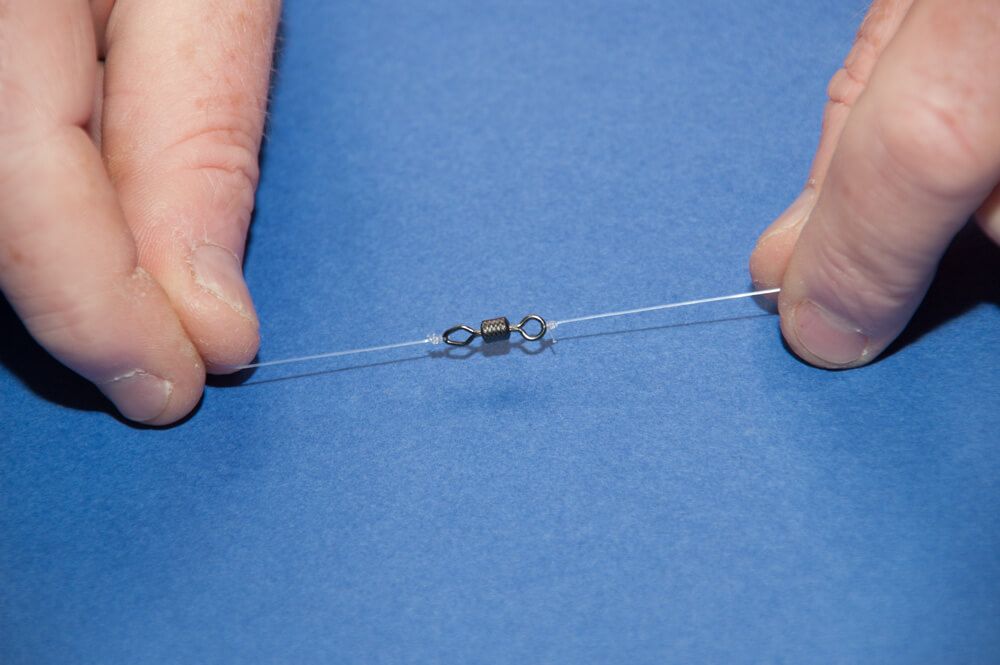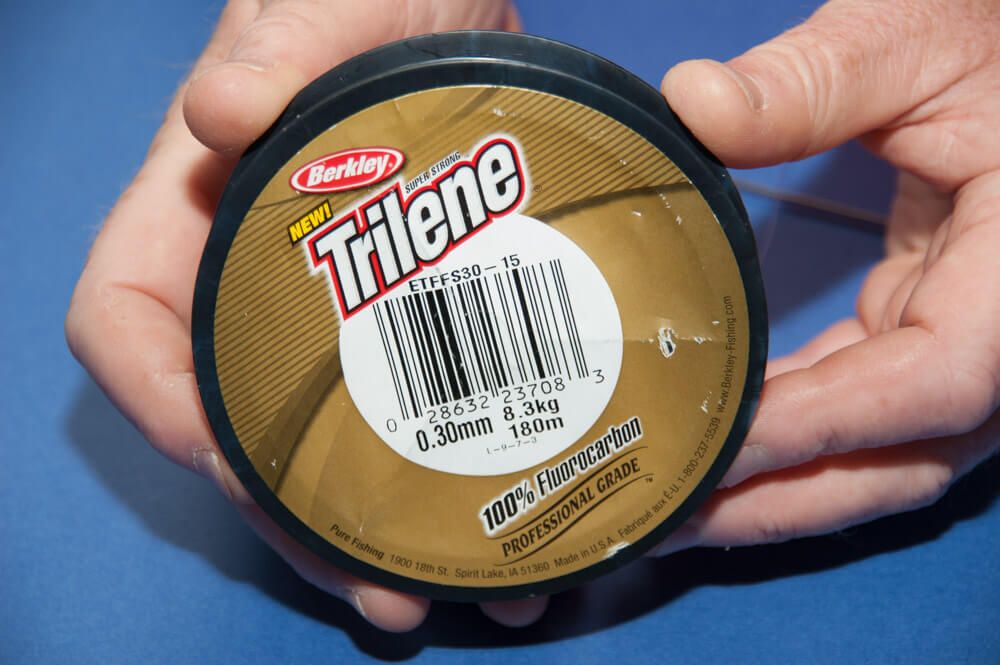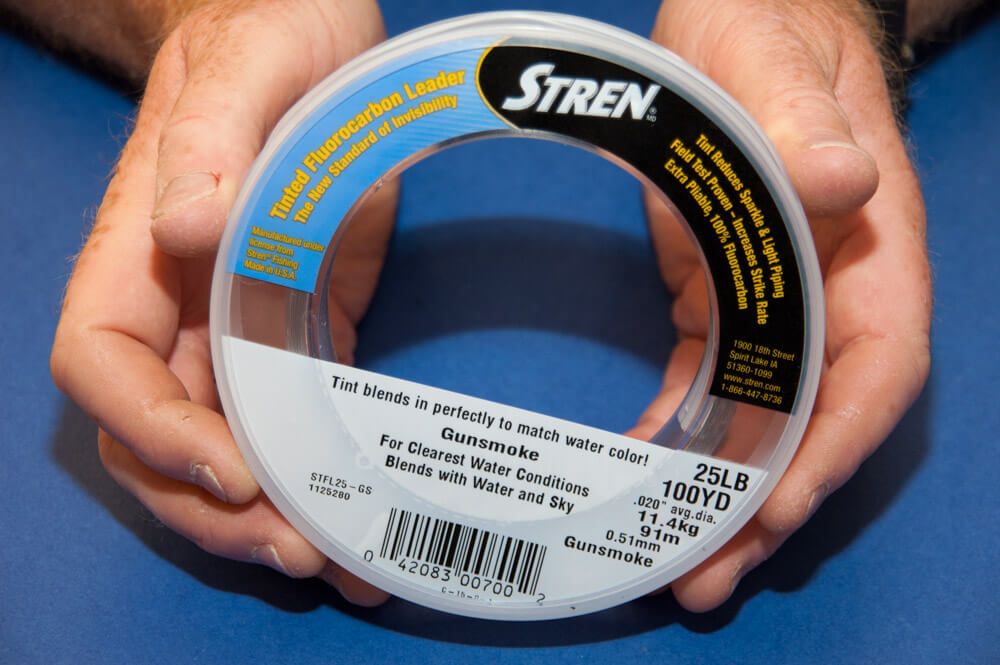Sea anglers fail to understand the true facts on Fluorocarbon line. So many all too often dismiss it just on price alone, but also, and amazingly, without actually trying it, or even considering when and where it can and will give you a real advantage.
I’ve been using it since it first came out for both UK fishing, and also when fishing abroad. Frankly, I wouldn’t be without it.
We’ll start with some facts about Fluorocarbon, and then look at specific instances where you’ll benefit by using it.
WHAT IS FLUOROCARBON?
A Japanese company, Kureha, were the originators of Fluorocarbon over a decade ago and are the manufacturers of the now world famous Seaguar Fluorocarbon brand that took the big game fishing world by storm when it came out.
Fluorocarbon is manufactured from polymer of fluorine, polymer being a molecule that is formed from a multiple of smaller molecules, which is built up over carbon.
The main advantage of Fluorocarbon is that it comes much closer to the natural refractive index of water making it almost invisible in water. Notice I said “almost” as it is not totally invisible in water as some writers have stated in the past, but it is much less so than standard traditional monofilament lines.

Few realise that it also suffers far less from direct exposure to ultra-violet rays meaning it is far more durable to long term outside exposure and general day to day storage than monofilament is.
The composition of the line also gives it much less stretch than mono has making it the ideal hook length and rig body line for maximum bite detection.
Fluorocarbon does not soak up water like mono does, which can result in as much as a 30% decrease in mono line strength once water has permeated in to the mono. Again this limited water ingress increases the overall life of the line as there is minimal breakdown.
Fluorocarbon lines do not float and will sink faster than traditional lines, which makes them ideal for presenting small baits hard on the seabed in light surf conditions as they will sink faster, with bait presentation appearing more natural.
Good quality Fluorocarbon has a harder surface texture giving it far more abrasion resistance for fishing over coarse sand when needing to fish fine diameter hook snoods, and over rough ground when after bass, plus it is stiffer in composition that mono for the same line diameter making it less likely to tangle in moving water such as surf tables.
KNOTTING QUALITIES
Inexperienced anglers frequently complain they have trouble knotting Fluorocarbon lines saying it proves weak when knotted. This is incorrect!
The more common knots such as the tucked half-blood can prove weak when used with Fluorocarbon, and your knot type choice is crucial. The Uni-knot and the Grinner knot prove the best, but it proves to be the case that Fluorocarbon will knot better when using these knots if you use one less main turn than you would normally.
For example, I only use the Uni-knot with Fluorocarbon lines as I’ve found it the best and most consistent, but tie it using only four turns inside the knots circle before closing on lines below 50lbs, and use just three turns in lines over 60lbs . I’ve never had this knot break during fishing, and use it on heavier 100lb Fluorocarbon leaders when tarpon fishing in the Florida Keys.

WHEN AND WHEN TO USE FLOURO CARBON LINES
Due to its refractive qualities making it far less visible to fish in clear water, it is an advantage to make your shore rig bodies, and especially your hook snoods, from Fluorocarbon when fishing broad daylight, shallow sunlit waters over clean sand, when bites will be very few and far between.
Keeping the diameters of your rig body and hook snoods to the minimum will also add to the days catch. Dropping down from 60lb to 30lb, or even 20lb rig bodies, and dropping your hooks snoods from 20lb to 12lb, and in some cases just 6lbs breaking strain, will make the difference in catching smaller fish such as flounders, dabs, rockling, pout and small school bass, and suffering a blank.
Try it if you don’t believe it and you’ll soon cotton on as to how good it is in these circumstances. Match anglers when close range fishing use this technique as well as the more experienced freelance anglers, which is why they rarely blank because they read the situation and adapt their rigs correctly.
Also remember that with the Fluorocarbon lines sinking faster than normal mono lines they stay tighter to the seabed, which is ideal for fishing the tiny baits needed when scratch fishing for small fish with lightweight hooks in sizes 4 to 8 during early spring and high summer.
Fluorocarbon snoods and rig body line are the way to go when daylight fishing in the surf tables for bass too, as the bass see your gear less and therefore feed with more confidence. Also being stiffer the Fluorocarbon line it is the better choice as it is less likely to tangle than mono of the same diameter, plus gives less lost fishing time and better bait presentation.
I also choose to use 30lb Fluorocarbon for my bass hook snoods when fishing crab over rough ground by day. This is because it has a much higher abrasion resistance than the mono I used to use and loses me less fish, plus has the low visibility factor for bass that in shallow calm water can be very spooky. It also produces a slight increase in bite detection, especially when I choose to use a 30lb Fluorocarbon leader tied direct to the hook snood via a small swivel with the lead swivel link running free on the leader to give me greater direct contact when fishing at close range.
I’m also experimenting with an American Fluorocarbon main reel line for rough ground bass fishing currently which looks to improve my overall catches, again for the reasons of higher abrasion when up against rocks and its more direct bite detection qualities.

When plug fishing, it also pays to rig the lures in front of about 8ft of 15lb to 20lb Fluorocarbon. Bass can be put off by standard mono when attacking surface worked plugs in gin clear seas with a good cloud base that silhouettes the line against the brightness as the bass attacks initially from below prior to interception.
I haven’t used mono leaders on my fly lines when fly fishing for bass fishing for years, only Fluorocarbon. From the moment I switched over my bass catches improved. I noticed more positive takes, the number of successful takes improved, and the number of fish following behind the fly without attacking diminished.
I don’t use tapered leaders for saltwater fly fishing either, just a single length of Fluorocarbon, the length dependent on the day. Longer in bright clear water conditions up to 12ft, shorter around 8ft, sometimes less if there is a little colour in the water in windier weather.
BOAT FISHING
I’ve also switched to using Fluorocarbon traces for fishing artificial eels and shads below flying collar booms over reefs and deep water wrecks when the water clarity is good, and when fishing live sandeels for bass over inshore wrecks and reefs. This has produced a definite advantage with increased catches and more positive takes all round.
I also use it when trolling over shallow reef ground for bass with both artificial eels and plugs. Again my overall hit rate has improved.
Fluorocarbon is also the only line material I rig my big game lures with when fishing abroad. It creates a much higher hit rate than standard heavy mono does and abrades better than mono when fighting big billfish and hard mouthed tarpon for long periods.
GETTING VALUE FOR MONEY
Fluorocarbon is more expensive than standard mono line, but you can see that it offers major advantages in certain circumstances that may justify the initial cost.

The way to start with Fluorocarbon is to buy just your most useful size or sizes. I’d suggest 20lb for standard shore rig snoods when targeting typical flatfish, dogfish, bass etc in surf and estuary conditions. I’d also look at 12lb, which is a good general scratching diameter when your fishing conditions are calm in gin clear water and bright sunlight. To start you need no other sizes. Judge its abilities for yourself from there and add other sizes as you deem necessary.
It’s a fact though, that more than any other line types, you get what you pay for when paying for Fluorocarbon lines. Hook snood line in 40 to 50-yard spool sizes costing less than £7 I’d treat carefully and test thoroughly as the materials and technology used to manufacture genuine Fluorocarbon lines dictate a high overall retail price.
I’ve found it false economy to buy the cheaper lines. For the little that you actually use, the more expensive proven brands are much cheaper in the long run.
That’s the simple truth about Fluorocarbon lines. If you fish night time sessions all the time, or fish coloured water like the Bristol Channel or The Mersey estuary, then forget it, you’ll never need it. If you’re an all round angler and find yourself fishing daylight, gin clear calm conditions in shallow water, then get some and try it properly over a protracted period. You’ll not regret it!
I’ve been using it since it first came out for both UK fishing, and also when fishing abroad. Frankly, I wouldn’t be without it.
We’ll start with some facts about Fluorocarbon, and then look at specific instances where you’ll benefit by using it.
WHAT IS FLUOROCARBON?
A Japanese company, Kureha, were the originators of Fluorocarbon over a decade ago and are the manufacturers of the now world famous Seaguar Fluorocarbon brand that took the big game fishing world by storm when it came out.
Fluorocarbon is manufactured from polymer of fluorine, polymer being a molecule that is formed from a multiple of smaller molecules, which is built up over carbon.
The main advantage of Fluorocarbon is that it comes much closer to the natural refractive index of water making it almost invisible in water. Notice I said “almost” as it is not totally invisible in water as some writers have stated in the past, but it is much less so than standard traditional monofilament lines.

Few realise that it also suffers far less from direct exposure to ultra-violet rays meaning it is far more durable to long term outside exposure and general day to day storage than monofilament is.
The composition of the line also gives it much less stretch than mono has making it the ideal hook length and rig body line for maximum bite detection.
Fluorocarbon does not soak up water like mono does, which can result in as much as a 30% decrease in mono line strength once water has permeated in to the mono. Again this limited water ingress increases the overall life of the line as there is minimal breakdown.
Fluorocarbon lines do not float and will sink faster than traditional lines, which makes them ideal for presenting small baits hard on the seabed in light surf conditions as they will sink faster, with bait presentation appearing more natural.
Good quality Fluorocarbon has a harder surface texture giving it far more abrasion resistance for fishing over coarse sand when needing to fish fine diameter hook snoods, and over rough ground when after bass, plus it is stiffer in composition that mono for the same line diameter making it less likely to tangle in moving water such as surf tables.
KNOTTING QUALITIES
Inexperienced anglers frequently complain they have trouble knotting Fluorocarbon lines saying it proves weak when knotted. This is incorrect!
The more common knots such as the tucked half-blood can prove weak when used with Fluorocarbon, and your knot type choice is crucial. The Uni-knot and the Grinner knot prove the best, but it proves to be the case that Fluorocarbon will knot better when using these knots if you use one less main turn than you would normally.
For example, I only use the Uni-knot with Fluorocarbon lines as I’ve found it the best and most consistent, but tie it using only four turns inside the knots circle before closing on lines below 50lbs, and use just three turns in lines over 60lbs . I’ve never had this knot break during fishing, and use it on heavier 100lb Fluorocarbon leaders when tarpon fishing in the Florida Keys.

WHEN AND WHEN TO USE FLOURO CARBON LINES
Due to its refractive qualities making it far less visible to fish in clear water, it is an advantage to make your shore rig bodies, and especially your hook snoods, from Fluorocarbon when fishing broad daylight, shallow sunlit waters over clean sand, when bites will be very few and far between.
Keeping the diameters of your rig body and hook snoods to the minimum will also add to the days catch. Dropping down from 60lb to 30lb, or even 20lb rig bodies, and dropping your hooks snoods from 20lb to 12lb, and in some cases just 6lbs breaking strain, will make the difference in catching smaller fish such as flounders, dabs, rockling, pout and small school bass, and suffering a blank.
Try it if you don’t believe it and you’ll soon cotton on as to how good it is in these circumstances. Match anglers when close range fishing use this technique as well as the more experienced freelance anglers, which is why they rarely blank because they read the situation and adapt their rigs correctly.
Also remember that with the Fluorocarbon lines sinking faster than normal mono lines they stay tighter to the seabed, which is ideal for fishing the tiny baits needed when scratch fishing for small fish with lightweight hooks in sizes 4 to 8 during early spring and high summer.
Fluorocarbon snoods and rig body line are the way to go when daylight fishing in the surf tables for bass too, as the bass see your gear less and therefore feed with more confidence. Also being stiffer the Fluorocarbon line it is the better choice as it is less likely to tangle than mono of the same diameter, plus gives less lost fishing time and better bait presentation.
I also choose to use 30lb Fluorocarbon for my bass hook snoods when fishing crab over rough ground by day. This is because it has a much higher abrasion resistance than the mono I used to use and loses me less fish, plus has the low visibility factor for bass that in shallow calm water can be very spooky. It also produces a slight increase in bite detection, especially when I choose to use a 30lb Fluorocarbon leader tied direct to the hook snood via a small swivel with the lead swivel link running free on the leader to give me greater direct contact when fishing at close range.
I’m also experimenting with an American Fluorocarbon main reel line for rough ground bass fishing currently which looks to improve my overall catches, again for the reasons of higher abrasion when up against rocks and its more direct bite detection qualities.

When plug fishing, it also pays to rig the lures in front of about 8ft of 15lb to 20lb Fluorocarbon. Bass can be put off by standard mono when attacking surface worked plugs in gin clear seas with a good cloud base that silhouettes the line against the brightness as the bass attacks initially from below prior to interception.
I haven’t used mono leaders on my fly lines when fly fishing for bass fishing for years, only Fluorocarbon. From the moment I switched over my bass catches improved. I noticed more positive takes, the number of successful takes improved, and the number of fish following behind the fly without attacking diminished.
I don’t use tapered leaders for saltwater fly fishing either, just a single length of Fluorocarbon, the length dependent on the day. Longer in bright clear water conditions up to 12ft, shorter around 8ft, sometimes less if there is a little colour in the water in windier weather.
BOAT FISHING
I’ve also switched to using Fluorocarbon traces for fishing artificial eels and shads below flying collar booms over reefs and deep water wrecks when the water clarity is good, and when fishing live sandeels for bass over inshore wrecks and reefs. This has produced a definite advantage with increased catches and more positive takes all round.
I also use it when trolling over shallow reef ground for bass with both artificial eels and plugs. Again my overall hit rate has improved.
Fluorocarbon is also the only line material I rig my big game lures with when fishing abroad. It creates a much higher hit rate than standard heavy mono does and abrades better than mono when fighting big billfish and hard mouthed tarpon for long periods.
GETTING VALUE FOR MONEY
Fluorocarbon is more expensive than standard mono line, but you can see that it offers major advantages in certain circumstances that may justify the initial cost.

The way to start with Fluorocarbon is to buy just your most useful size or sizes. I’d suggest 20lb for standard shore rig snoods when targeting typical flatfish, dogfish, bass etc in surf and estuary conditions. I’d also look at 12lb, which is a good general scratching diameter when your fishing conditions are calm in gin clear water and bright sunlight. To start you need no other sizes. Judge its abilities for yourself from there and add other sizes as you deem necessary.
It’s a fact though, that more than any other line types, you get what you pay for when paying for Fluorocarbon lines. Hook snood line in 40 to 50-yard spool sizes costing less than £7 I’d treat carefully and test thoroughly as the materials and technology used to manufacture genuine Fluorocarbon lines dictate a high overall retail price.
I’ve found it false economy to buy the cheaper lines. For the little that you actually use, the more expensive proven brands are much cheaper in the long run.
That’s the simple truth about Fluorocarbon lines. If you fish night time sessions all the time, or fish coloured water like the Bristol Channel or The Mersey estuary, then forget it, you’ll never need it. If you’re an all round angler and find yourself fishing daylight, gin clear calm conditions in shallow water, then get some and try it properly over a protracted period. You’ll not regret it!

